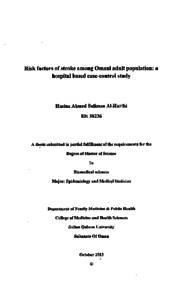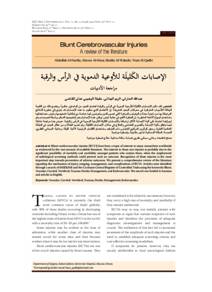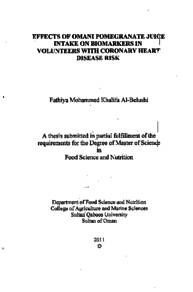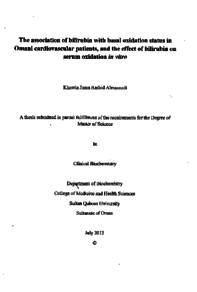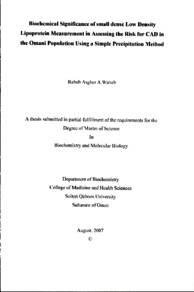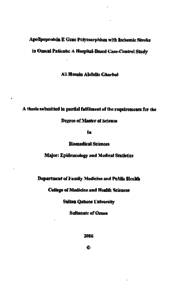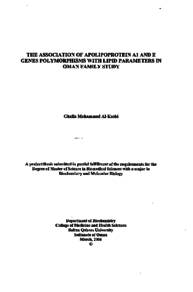Document
Risk factors of stroke among Omani adult population : a hospital based case-control study.
Publisher
Sultan Qaboos University
Gregorian
2013
Language
English
English abstract
Stroke is one of the leading causes of death and disability worldwide. It was the leading cause of death in 10% of total deaths in 2008 and it was associated with about 3.2% of the global lost DALYs in 2011. However, 80% of stroke cases can be prevented by controlling its risk factors. This study was conducted to evaluate the risk factors and its impact in the development of stroke in the Omani population,
Methods: An ambi-directional hospital based case-control study conducted in Sultan Qaboos University Hospital and the Royal Hospital in Muscat-Oman. In this study 300cases and 300 matched controls for age and gender were recruited, Pre tested transformation sheet was designed to assess the risk factors and to describe the main characteristics of stroke in this population. Analyses were carried out using SPSSV.20 software. Statistical associations were carried out using Chi-Square test and student t-test. The odds ratios under univariate and multivariate setup, were obtained using logistic regression analysis. Results: Out of the 300 cases there were 189 (63%)male and 111 (37%) female with mean age of 61.9(SD 13.3).Around 59% of the cases were55-75years old. Ischemic stroke (IS) was diagnosed in 85% of the cases where, the cardio embolic (CE) etiology was the most common (32%) subtype of IS. Hemorrhagic stroke and CE related IS were associated with more severe form (p<0.05) and accounted for most of the inpatient deaths due to stroke (p <0.05). Family history of stroke (FHx), atrial fibrillation(AF), hypertension(HTN), dyslipidemia, and alcohol consumption were the predominant independent risk factors for ischemic stroke development with OR of 6.7 5.9,93.7, 2.1, and 3.2 respectively (p<0.05). In addition, obesity based on BMI and regular physical activity ORs were found insignificant (p>0.05). Conclusion: In this study, FHx was found to be the risk factor with the largest OR for stroke in the Omani population which justifies more sophisticated researches about the role of genetics in this field. In addition, HTN, dyslipidemia and diabetes were highly prevalent among cases, primary and secondary prevention should be applied to avoid more stroke cases.
Member of
Resource URL
Arabic abstract
السكتة الدماغية هي واحدة من الأسباب الرئيسية الوفاة والعجز في جميع أنحاء العالم . وقد قدرت نسبة الوفاة الناتجة عن السكتة الدماغية ب 10% من مجموع الوفيات في عام 2008 ارتبطت السكتة الدماغية مع حوالي 3 . 2 % سنة الحياة العوق المعدلة العالمية (DALYs) في عام 2011 . ومع ذلك ، يمكن منع 80 % من حالات السكتة الدماغية عن طريق التحكم في عوامل الاختطار ذات الصلة . وقد أجريت هذه الدراسة لتقييم عوامل الأخطار المرتبطة بالسكتة الدماغية في العمانيين . الأساليب : الدراسة أجريت على 300 مريض بالسكتة الدماغية و300 حالة ضبط (بنفس الجنس والعمر) تم تجميعهم من مستشفى جامعة السلطان قابوس والمستشفى السلطاني بمسقطط سلطنة عمان .وقد تم تصميم ورقة استبيان (تم اختبارهاعلى عينة استطلاعية) لتقييم عوامل الخطر ووصف الخصائص الرئيسية للسكتة الدماغية في هذه الفئة من السكان . وقد أجريت التحليلات باستخدام 20.SPSSV البرمجيات. تم تطبيق التحليلات الاحصائية باستخدام T-اختبار واختبار مربع كاي . نسب الأرجحية اختبرت تحت الإعداد وحيد المتغير و المتغيرات المتعددة ، التي تم الحصول عليها باستخدام تحليل الانحدار اللوجستي . النتائج : من 300 حالة 189 ( 63 % ) كانوا من الذكور و 111 (37 %) من الإناث مع متوسط عمر 61 . 9 (13 . 3 SD ) حوالي 59 % من الحالات كان من الفئة العمرية 55-75سنة. تم تشخيص السكتة الدماغية (ischemic stroke : IS ) في 85 % من الحالات في حين شخص النزيف الدماغي في (15%) ، وكان القلب الصمي (Cardioembolic) (32 %) النوع الفرعي الأكثر شيوعا من 1S . ارتبط النزيف الدماغي و السمنة الدماغية المتعلقة بالقلب الصمي باكثر الحالات شدة وباغلب الوفيات المرتبطة بالسكتة الدماغية داخل المستشفى (P< 0 . 05). وقد تبين أن التاريخ العائلي بالسكتة الدماغية و الرجفان الأنيني و ارتفاع ضغط الدم ودسليبيدمیا و استهلاك الكحول هي العوامل السائدة مستقلة الخطر لحصول السكتة الدماغية , وحسبت نسب الأرجحية 6 . 7 5 . 9 ، و 3 . 7 ، و 2 . 1 ، و 3 . 2 على التوالي (P< 0 . 05) . بالاضافة لم تكن السمنة وممارسة الرياضة بانتظام ذات نسب أرجحية ذات أهمية في هذه الدراسة. الخلاصة: في هذه الدراسة ، وجد ان حدوث سكتة دماغية في اقارب الدرجة الأولى يعتبر عامل خطر ذا أهمية الحصول السكتة الدماغية في العمانيين مما يبرر الحاجة لأبحاث أكثر تطورا حول دور الوراثة في هذا المجال . وبالإضافة إلى ذلك ، انتشار ارتفاع ضغط الدم والكوليترول والسكري يشير الى اهمية تفعيل الوقاية من هذه الحالات في العمانيين.
Category
Theses and Dissertations

